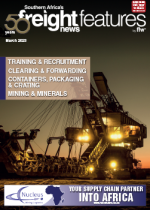The growing demand for electric vehicles (EVs) will lead to an increase in demand for base metal commodities within the SADC region, boding well for logistics service providers wanting to expand their footprint in the mining and minerals sector.According to Mndeni Ngcobo, sales and marketing manager at SA Cargo Services, countries such as the Democratic Republic of the Congo, which has been a major contributor to all the world’s industrial revolutions, is well positioned to take part in the world’s latest energy revolution by providing much-needed cobalt, copper, nickel and lithium. South Africa can also use the opportunity to its benefit, he says.“African countries must however ensure they are in positions where they can leverage this new revolution by planning and executing sustainable business models which will benefit local production and, of course, communities.”In line with most forecasts and on the back of the increasing global challenges and rising inf lation, SA Cargo Services expects pricing across most commodities to trend lower in 2023 than was the case in 2022 when it was largely buoyed by the global restocking post Covid-forced lockdowns, and further pressures that came from the Russia-Ukraine war, which put a strain on the supply of gas from the region to Europe, which then had to rely on more imports of coal.“The coal prices have started to trend down, and while they may rebound, we do not foresee these going back to the heights reached at their peak in 2022,” logistics executive, Hans Modipane, told Freight News. “While this is the case, we still believe that, for South Africa in particular, there may still be a need to fulfil contracts that were not fully satisfied due to the inefficiencies that were created by rail shortages and port delays."Asked about which minerals were expected to grow, Modipane said the demand for lithium had already surged over the past decade. “As countries scramble to diversify their energy mix and car OEMs look towards a more sustainable future, the commodity stands to be a truly dominant player in the 2020s. Another interesting development has been the ban on raw lithium exports out of neighbouring Zimbabwe. According to the government, it loses approximately $1.8 billion in minerals, and this ban intends to create a strong local beneficiation environment, thus making them a key stakeholder on the global stage. Provided the vision is well planned and executed, there is no reason why Africa can’t be the home of a thriving lithium battery industry,” he said.According to Ngcobo, one cannot speak about mining trends without speaking about Transnet. “The SOE has certainly made some great strides in driving growth within the manganese mining sector over the years, where we’ve seen new entrants account for about 8-15% of overall capacity. The main challenge over the next couple of years will be to see these same numbers being replicated within the coal and iron ore sectors. Transnet’s announcement that it will double rail and port capacity for emerging manganese miners will effectively lead to reduced allocations for established miners from April 2023 by two million tons, which is great news for emerging miners.”Both Ngcobo and Modipane said while the overall outlook for the mining sector was positive, it did need to address some of the challenges facing the sector such as rail constraints, energy generation, safety and infrastructure security, port capacity and port efficiency, especially with regard to cargo and vessel turnaround times.“2022 proved that South Africa’s main natural resources are the backbone of global stability, however we must address the challenges to move forward,” they said

